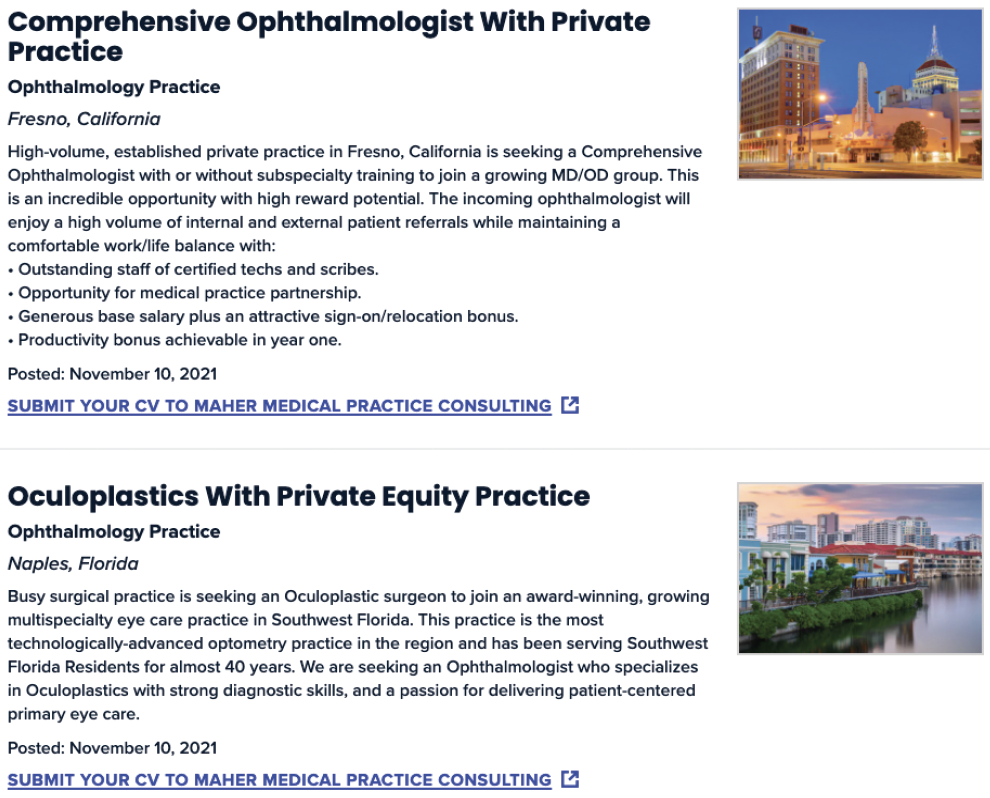
As you may already be painfully aware, physician recruitment changed dramatically in recent years. In the past, practices could place an ad, sit back, and wait for candidates to come rushing through the front door. Now, recruitment is a game of searching; networking; and reaching out to potential candidates through emails, phone calls, texts, and messages, and then trying to sell them on how great your practice is to join. The fact that you are reading this article tells me that you have been trying to find the right ophthalmologist to join your practice and you are hoping I will share the secret that will unlock the physician vault.
I have a few strategies that may be beneficial throughout your search, but I find that multiple tweaks to a practice’s search process are typically required to find the right doctor to recruit.
A SHORTAGE OF DOCTORS
The US population is aging, and the number of senior citizens is expected to nearly double over the next 40 years. A static number of ophthalmologists, however, complete their residency and fellowship every year.
The Midwest has felt the shortage of ophthalmologists for years as young ophthalmologists move to the coasts, but even the popular coastal regions are now feeling a pinch as well. According to the US Department of Health and Human Services, the West will experience a 28% increase in demand for ophthalmologists in the next few years.
WHERE AND HOW TO SEARCH
Place ads on association and other ophthalmology specialty websites, LinkedIn, job boards such as those at regional meetings and on YoungMD Connect (youngmdconnect.com/jobs; Figure), state association websites, and Instagram.

Figure. Sample job postings on YoungMD Connect.
Placing ads and waiting for responses is no longer enough to find candidates. Being proactive increases your chances of finding great candidates. Networking, emailing, calling, texting, and messaging potential candidates gets attention. Young ophthalmologists don’t need to work hard to find a job because opportunities are abundant and employers are usually coming to them.
WHAT DO CANDIDATES WANT?
What are young ophthalmologists looking for in an employment opportunity? As salaries skyrocket, many think that they are interested only in money. I have found, however, that many young ophthalmologists are searching for a job in a medium to large practice where they have a chance of finding an excellent mentor.
It is vital that candidates have an opportunity to connect and build a relationship with a managing partner, a retiring partner, the newest partner, or whoever is willing to mentor them. In a recent survey of residents that I conducted, more than 60% feared that they would not be ready to start seeing patients on their own. It is therefore imperative that candidates be introduced to the managing partner as soon as possible in the interviewing process.
FIVE TIPS for physician recruitment
No. 1: Respond promptly. Contact candidates within 48 hours of when they show interest in the position available at your practice. I have seen far too many qualified candidates move on to pursue another opportunity because the practice waited weeks to respond to a candidate’s interest in a position.
No. 2: Assume that your candidate is evaluating at least three to five other job offers. Don’t assume that your practice is a candidate’s only suitor. Young ophthalmologists are often fielding multiple offers, so make sure your offer is enticing but feasible for your practice. Offers usually include a salary, a production bonus, moving expenses, 3 weeks of paid vacation, and 1 week of paid continuing medical education. Occasionally, offers also include a signing bonus. Leave room for negotiation.
No. 3: Set realistic expectations. Make sure that candidates understand the expected call schedule, the number of support staff on the team, the travel and operating schedules, and the typical number of patients to be seen daily. Will patients be coming from a retiring physician, a new referral source, or a physician leaving the practice, or will the new hire be required to market themselves? Setting realistic expectations upfront fosters a successful long-term future in your practice for the right ophthalmologist.
No. 4: Plan ahead. Start searching before your practice requires a new physician—at least a year in advance and possibly longer if yours is a rural practice. Additionally, stay open-minded about all applicants because some practices are lucky to find just one person interested in their opportunity. Every candidate should be considered as a potential new hire. You should also follow up with candidates in a timely manner, and the next step of the interview process should be scheduled promptly.
No. 5: Demonstrate a mentorship opportunity and dedicate the time necessary for onboarding. Introducing candidates to the managing partner or another personable provider can help build the mentorship relationship that most young ophthalmologists are seeking. Once a candidate has been offered the position, prepare the practice and make sure you have ample time to credential, train, and transition the new physician to promote their long-term success.
CONCLUSION
The shortage of ophthalmologists is being felt in every region of the country. Recruiting has therefore become a time-consuming process. To improve your chances of finding the right candidate, start your search up to a year in advance, keep an open mind, respond promptly to all candidates, set realistic expectations upfront, and introduce candidates to potential mentors in the practice. Even when the recruitment process is perfect, success sometimes simply comes down to timing and a little bit of luck.




